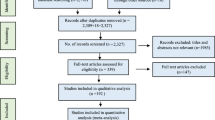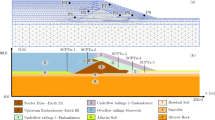Abstract
Rock slope failure along road cuts in weathered elevated terrains is a frequent geotechnical issue. The slope stability probability classification (SSPC) system is commonly employed as a reliable, systematic, quick, and probabilistic approach to analyze rock slope failures. The applicability of this technique on weathered metamorphic rock slopes, particularly in high-grade metamorphic terrains like Sri Lanka, has been poorly studied. This study utilized 22 road cuts made in metamorphic rock masses along Kandy-Randenigala and Kandy-Mahiyangana roads in Sri Lanka. The SSPC system was applied to evaluate the stability of cut slopes, and the geotechnical properties of the rock masses were calculated. The slope stability probabilities were validated against the actual stability conditions of the slopes. Rock mass rating (RMR) and Geological Strength Index (GSI) analyses were employed to compare the rock mass properties derived from SSPC. The orientation-dependent analysis of SSPC agreed with the actual stability conditions of the analyzed cut slopes by 91%, except for wedge failures. The rock mass cohesion values and friction angles were derived from SSPC aligned with the literature and were reliable for weathered metamorphic rock masses in Sri Lanka. The current study recommends the SSPC orientation-dependent analysis for conducting a rapid and preliminary assessment of slope stability in structurally controlled weathered metamorphic terrains.





Similar content being viewed by others
References
Athapaththu, A 2003, ‘Variation of geotechnical properties in some weathering profiles of Sri Lanka’, MPhil thesis, University of Peradeniya, Peradeniya
Bar N, Barton N (2017) ’The Q-slope method for rock slope engineering. Rock Mech Rock Eng 50:3307–3322
Barton N (1973) Review of a new shear-strength criterion for rock joints. Eng Geol 7(4):287–332
Barton N, Bar N (2015) ‘Introducing the Q-slope method and its intended use within civil and mining engineering projects’, Future development of rock mechanics; Proceedings of the ISRM regional symposium, Eurock, Salzburg 7–10 October 2015, pp 157–162
Basahel H, Mitri H (2017) Application of rock mass classification systems to rock slope stability assessment: a case study. J Rock Mech Geotech Eng 9:993–1009
Bieniawski, Z 1993, ‘Classification of rock masses for engineering: the RMR system and future trends’. In: Rock Testing and Site Characterization, Elsevier, pp 553–573
Cabria X (2015) ‘Effects of weathering in the rock and rock mass properties and the influence of salts in the coastal roadcuts in Saint Vincent and Dominica’, Master thesis, University of Twente
Canal A, Akin M (2016) Assessment of rock slope stability by probabilistic-based slope stability probability classification method along highway cut slopes in adilcevaz-bitlis (turkey). J Mt Sci 13:1893–1909
Chen Z (1995) ‘Recent developments in slope stability analysis’; Proceedings of the 8th International Congress ISRM, Tokyo, Japan. pp 1041–1048
Cooray P (1994) The Precambrian of Sri Lanka: a historical review. Precambr Res 66:3–18
Das I, Sahoo S, van Westen C, Stein A, Hack R (2010) Landslide susceptibility assessment using logistic regression and its comparison with a rock mass classification system, along a road section in the northern Himalayas (India). Geomorphology 114:627–637
Ersöz T, Topal T (2018) Assessment of rock slope stability with the effects of weathering and excavation by comparing deterministic methods and slope stability probability classification (SSPC). Environ Earth Sci 77(17):1–18
Hack R, Price D, Rengers N (2003) ‘A new approach to rock slope stability–a probability classification (SSPC). Bullet Eng Geol Environ 62:167–184
Hack R, Huisman M (2002) ‘Estimating the intact rock strength of a rock mass by simple means’, In: Proceedings of 9th congress of the international association for engineering geology and the environment, Durban, pp 16–20
Hack R (1998) ‘Slope stability probability classification; SSPC, 2nd version’, PhD thesis, University of Technology Delft, International Institute for Aerospace Survey and Earth Sciences, ITC, Delft
Jaiswal A, Verma AK, Singh TN (2023) Evaluation of slope stability through rock mass classification and kinematic analysis of some major slopes along NH-1A from Ramban to Banihal North Western Himalayas. J Rock Mech Geotech Eng 16(1):167–182. https://doi.org/10.1016/j.jrmge.2023.02.021
Jayawardena U (2001) A study of the engineering properties of Sri Lankan rocks. Engineer 34(2):7–20
Jayawardena U (2011) Correlations between some strength properties of metamorphic rocks of Sri Lanka. J Geol Soc Sri Lanka 14:65–66
Laubscher D (1990) A geomechanics classification system for the rating of rock mass in mine design. J South Afr Inst Min Metall 90(10):257–273
Li X, Xu Q (2016) Application of the sspc method in the stability assessment of highway rock slopes in the Yunnan province of china. Bull Eng Geol Env 75:551–562
Lindsay P, Campbell R, Fergusson D, Gillard G, Moore T (2001) Slope stability probability classification, Waikato coal measures, New Zealand. Int J Coal Geol 45:127–145
Lindsay P, Anderson J, Bourke F, Campbell R, Clarke L (2000) ‘Predicting slope stability in open pit gold and coal mines’. In: New Zealand minerals and mining conference proceedings, pp 29–31
Marinos P, Hoek E (2000) ‘GSI: a geologically friendly tool for rock mass strength estimation’. In: ISRM international symposium, OnePetro, 2000 Nov 19
Palmstrom A (1974) ‘Characterization of jointing density and the quality of rock masses’, Internal Report, A.B. Berdal, Norway, 26p (in Norwegian)
Pantelidis L (2009) Rock slope stability assessment through rock mass classification systems. Int J Rock Mech Min Sci 46:315–325
Romana M, Toma´s R, Sero´n JB (2015) ‘Slope mass rating (SMR) geomechanics classification: thirty years review’. In: ISRM Congress 2015 proceedings—international symposium on rock mechanics, Quebec, Canada, ISBN: 978–1–926872–25–4, p 10
Romana M (1985) ‘New adjustment ratings for application of Bieniawski classification to slopes’. In: Proceedings of the international symposium on role of rock mechanics, Zacatecas, Mexico, pp 49–53
Romana M (1993) ‘A geomechanical classification for slopes: slope mass rating’. In: Rock testing and site characterization, Elsevier, pp 575–600
Sarkar S, Kanungo D, Kumar S (2012) ‘Rock mass classification and slope stability assessment of road cut slopes in Garhwal Himalaya India.’ Geotech Geol Eng 30:827–840
Sonmez H, Ulusay R (1999) Modifications to the geological strength index (GSI) and their applicability to stability of slopes. Int J Rock Mech Min Sci 36:743–760
Umrao R, Singh R, Ahmad M, Singh T (2011) Stability analysis of cut slopes using continuous slope mass rating and kinematic analysis in Rudraprayag district, Uttarakhand. Geomaterials 1(3):79–87. https://doi.org/10.4236/gm.2011.13012
Wusqa U, Sadisun IA (2019) ‘Assessment of rock slope stability by probabilistic-based slope stability probability classification method along road cut slopes in Tawaeli-Toboli (Central Sulawesi)’. Proceedings of International Conference on “Landslide and Slope Stability” (SLOPE 2019), Bali – Indonesia, September 26 – 27
Author information
Authors and Affiliations
Corresponding author
Ethics declarations
Competing interests
The authors declare no competing interests.
Rights and permissions
About this article
Cite this article
Lasantha, H.S., Athapaththu, A.M.R.G. Advancing slope stability assessment in weathered metamorphic terrains: a probabilistic approach utilizing the SSPC method on Highland Complex, Sri Lanka. Bull Eng Geol Environ 83, 54 (2024). https://doi.org/10.1007/s10064-024-03546-8
Received:
Accepted:
Published:
DOI: https://doi.org/10.1007/s10064-024-03546-8




